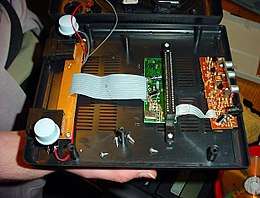Ending-Man Terminator
|
| |
| Manufacturer | Ending-Man |
|---|---|
| Type | Video game console |
| Generation | Third |
| Release date | 1992 |
| Discontinued | Around 2014-2016 |
| Media | ROM cartridge |
| CPU | 1.66-1.79 MHz emulating 8-bit MOS 6502 |
Terminator 2 (Chinese: 终结者二; pinyin: Zhōngjié zhě èr; real console name Super Design Ending-Man BS-500 AS) was a video game console sold in Poland, Slovakia, Serbia, Croatia, Bulgaria, Romania, Bosnia and Herzegovina, Albania, Montenegro, India, Kenya and Hungary. It was also sold in Italy as "top consolle". In Spain it was usually received as a marketing gift for those assisting sales conferences organized by different companies, usually by assisting to a hotel as a promotional tool. It is a hardware clone of the Nintendo Famicom.

Hardware
| Processor | Emulation of 8-bit MOS 6502 1.66-1.79 MHz | |
| Video | Clock | 5.37 MHz |
| Resolution | 256 x 240 | |
| Colour Palette | 25 on screen (out of 64 possible) | |
| Standard | Usually set by jumpers
Usually PAL 50Hz, can also operate in NTSC, NTSC 4.43 and PAL-60Hz | |
| Sound | 5-channel mono | 1 channel noise 1 PCM 3 channels for sounds |
| Media | ROM cartridge (Nintendo Famicom 60-pin standard) | |
Background
This particular Nintendo-clone was hugely popular in Poland[1], Serbia, Montenegro, Croatia, Bulgaria,[2][3] Romania, Pakistan, India, Kenya, Iran and Bosnia, throughout the late 1990s and early 2000s. The system has gained cult status, and was widely available on flea markets and even in some electronic stores. Due to political and economical restraints, the fourth and the fifth generation consoles such as the Sega Genesis, SNES, or PlayStation were not readily available in these countries. The third generation remained highly popular, particularly Terminator 2 which was the one of most successful Famicom clones. It left a mark in pop culture and 1990s-2000s youth, establishing itself as antonomasia for 8-bit video gaming, to the point of being more popular than the original NES in these regions.
Terminator 2, like most known Famicom clones, was compatible with 60-pin Famicom cartridges and NES games, which could be played using a special converter. Original Nintendo games were not popular however, due to mass copyright infringement and lack of officially licensed products on the market. The majority of the games sold with and for the system were cheap unlicensed copies, manufactured mostly in Russia and China. Games for the Terminator 2 were still widely available in Central and Eastern Europe throughout 2000s, mostly on street markets and in small toy stores.
The typical retail set included the system, two detachable controllers (both with "turbo" buttons, which meant 4 buttons in total), a light gun, which also based on the original Nintendo gun accessory except the design, power supply and RF cable. The console had a built-in RF modulator, as well as mono audio and composite video through RCA connectors. The system itself could include built-in games, but most common versions were bundled with cartridges such as "1000000 in 1" or "9999999 in 1", supposedly featuring a million games, only a small number of which actually being separate games and the rest just renamed versions of the latter. Usually these were popular games such as: "Super Mario Bros." or "Duck Hunt". Sometimes they were renamed though, possibly in an attempt to avoid lawsuits.
Design
Terminator's box art was inspired by Japanese Sega Mega Drive 2, using colourful triangles in the background, similar logo writings.[4] The unit itself combines design patterns of both Japanese MD and MD 2, being similar size and shape to the later but having characteristic CD-ROM inspired circle around the cartridge slot and blue reset and power buttons inspired by earlier MD's reset button. Some sets even featured a controller which looked like 6 button controller for MD.[5]
Pricing
The Terminator 2 consoles were mass-marketed by most of the major and smaller electronic stores. It is difficult to determine an exact price for the system, but in place like Gabrovo, Bulgaria in the mid 90s, one could buy it for the rough equivalent of €10. In Romania in 2015 it cost about €10. In Sarajevo, Bosnia and Herzegovina after the Bosnian war it would cost equivalent of €15. In Poland it used to cost equivalent of €9 to €15 and the games €1 to €2. In Georgia, in early 2000s it used to cost equivalent of €6 to €15.
From 1998 until 2000, the Terminator 2 console used to cost €15 to €25 in Serbia. A normal price for a copied cartridge was €0.5 part of which were unauthorized "1,000,000 in 1" cartridges, containing several repeating games. In the early 2000s, Sony PlayStation became available in Serbia, making Terminator obsolete. In 2013 a price of the console was €11 and it was still sold in Chinese shopping malls throughout Serbia.
See also
References
- ↑ Kubos123 (2012-03-06). "NESblog: Pegasus BS-500AS". NESblog. Retrieved 2017-10-25.
- ↑ forum.uni-sofia.bg, Sofia University St. Kl. Ohridski
- ↑ zamunda.net, discussion on a torrent tracker
- ↑ "Amintiri din copilarie: Hasta la vista baby!". Zona IT (in Romanian). 2014-05-04. Retrieved 2017-10-25.
- ↑ Liftarn (2010-04-04), Jurasic Park branded 8-bit Nintendo clone., retrieved 2017-10-25
External links
| Wikimedia Commons has media related to Famicom/NES unlicensed hardware clones. |